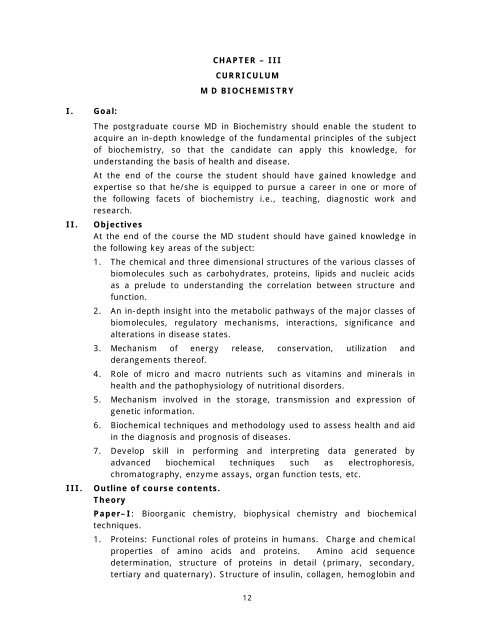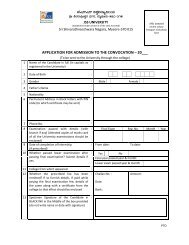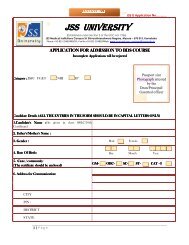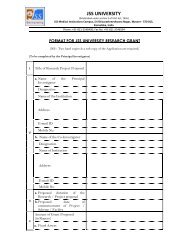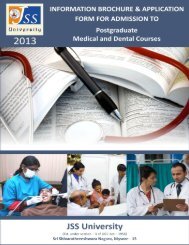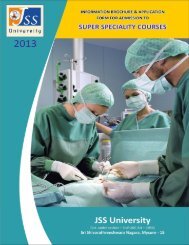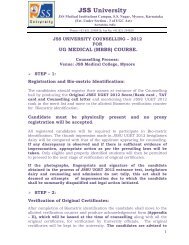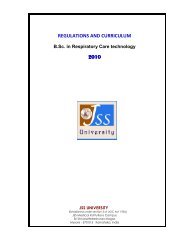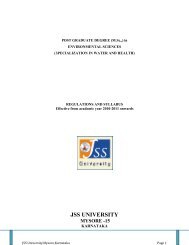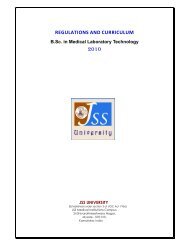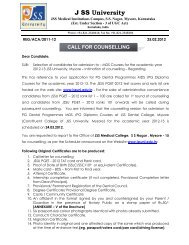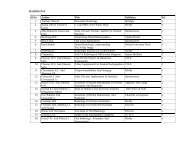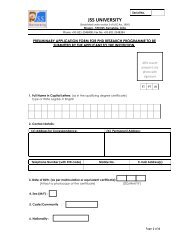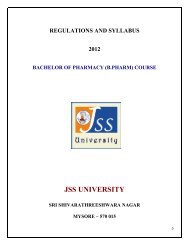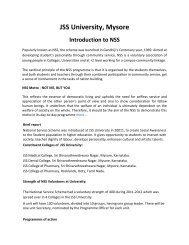III CURRICULUM MD BIOCHEMISTRY I. Goal - JSS University ...
III CURRICULUM MD BIOCHEMISTRY I. Goal - JSS University ...
III CURRICULUM MD BIOCHEMISTRY I. Goal - JSS University ...
Create successful ePaper yourself
Turn your PDF publications into a flip-book with our unique Google optimized e-Paper software.
I. <strong>Goal</strong>:<br />
II.<br />
<strong>III</strong>.<br />
CHAPTER – <strong>III</strong><br />
<strong>CURRICULUM</strong><br />
M D <strong>BIOCHEMISTRY</strong><br />
The postgraduate course <strong>MD</strong> in Biochemistry should enable the student to<br />
acquire an in-depth knowledge of the fundamental principles of the subject<br />
of biochemistry, so that the candidate can apply this knowledge, for<br />
understanding the basis of health and disease.<br />
At the end of the course the student should have gained knowledge and<br />
expertise so that he/she is equipped to pursue a career in one or more of<br />
the following facets of biochemistry i.e., teaching, diagnostic work and<br />
research.<br />
Objectives<br />
At the end of the course the <strong>MD</strong> student should have gained knowledge in<br />
the following key areas of the subject:<br />
1. The chemical and three dimensional structures of the various classes of<br />
biomolecules such as carbohydrates, proteins, lipids and nucleic acids<br />
as a prelude to understanding the correlation between structure and<br />
function.<br />
2. An in-depth insight into the metabolic pathways of the major classes of<br />
biomolecules, regulatory mechanisms, interactions, significance and<br />
alterations in disease states.<br />
3. Mechanism of energy release, conservation, utilization and<br />
derangements thereof.<br />
4. Role of micro and macro nutrients such as vitamins and minerals in<br />
health and the pathophysiology of nutritional disorders.<br />
5. Mechanism involved in the storage, transmission and expression of<br />
genetic information.<br />
6. Biochemical techniques and methodology used to assess health and aid<br />
in the diagnosis and prognosis of diseases.<br />
7. Develop skill in performing and interpreting data generated by<br />
advanced biochemical techniques such as electrophoresis,<br />
chromatography, enzyme assays, organ function tests, etc.<br />
Outline of course contents.<br />
Theory<br />
Paper–I: Bioorganic chemistry, biophysical chemistry and biochemical<br />
techniques.<br />
1. Proteins: Functional roles of proteins in humans. Charge and chemical<br />
properties of amino acids and proteins. Amino acid sequence<br />
determination, structure of proteins in detail (primary, secondary,<br />
tertiary and quaternary). Structure of insulin, collagen, hemoglobin and<br />
12
myoglobin. Methods of study of structure of proteins and different<br />
levels of structural organization. Biologically important peptides,<br />
conjugated proteins, lipoproteins and glycoproteins, structure of<br />
immunoglobulins.<br />
2. Carbohydrates: Biological importance of carbohydrates, chemistry,<br />
structure and properties of monosaccharides, disaccharides and<br />
polysaccharides. Structure and functions of heteropolysaccharides.<br />
3. Lipids: Biological importance of lipids. Chemistry and structure of<br />
simple, compound and derived lipids. Chemistry of steroids.<br />
4. Nucleic acids: Biological importance of nucleic acids. Structure of<br />
nucleic acids and biologically important nucleotides. Methods of study<br />
of base sequence of DNA. Structure and functions of gene with respect<br />
to mammalian genome, recombinant DNA technology. General<br />
principles of blotting techniques. PCR and its application in medicine.<br />
5. Biophysical Chemistry<br />
a. pH, buffers, Henderson – Hasselbalch equation, principles and<br />
procedures of determination of pH, pO 2 , pCO 2 (blood gas analysis).<br />
b. Isotopes – detection and measurement of stable and radioactive<br />
isotopes; their application in biochemistry.<br />
c. Bioenergetics – free energy change, high-energy linkages, redox<br />
potentials.<br />
6. Biochemical Techniques<br />
a. Chromatography: Principles and applications of paper, thin layer, ion<br />
exchange, gas phase and affinity chromatography, HPLC, gel<br />
filtration and its applications.<br />
b. Electrophoresis: Principles, procedure and applications of paper,<br />
agarose gel, polyacrylamide, capillary, immuno-electrophoresis.<br />
Isoelectric focusing.<br />
c. Photometry and spectrophotometer: principle and applications.<br />
d. Flame photometry: principle and applications.<br />
e. Ultra centrifugation techniques: Their applications in the study of<br />
lipoproteins.<br />
f. Radio immuno assay: competitive binding assay – Principles<br />
procedure and applications. Elisa – Principles and applications.<br />
g. Ion selective electrodes: Their applications in medicine.<br />
h. Cell fractionation: Isolation and purification of sub cellular particles,<br />
biochemical markers of different subcellular organelles.<br />
i. Recent advances in medical laboratory technology and<br />
instrumentation: semi auto analyser, auto analyzer, PCR etc.<br />
Paper–II: Intermediary Metabolism and Biochemical Genetics<br />
1. Introduction to intermediary metabolism, various methods of study of<br />
intermediary metabolism with examples. Their advantages and<br />
disadvantages.<br />
13
2. Biological oxidation – structure of mitochondria, its role in biological<br />
oxidation, electron transport chain, mechanisms of electron transport<br />
and oxidative phosphorylation. Regulation of oxidative phosphorylation.<br />
3. Carbohydrate metabolism: A detailed discussion of the metabolic<br />
pathways as it occurs in humans.<br />
4. Amino acid metabolism: A detailed study of metabolism of the amino<br />
acids in humans.<br />
5. Lipid metabolism: Fatty acids – oxidation of saturated and unsaturated<br />
fatty acids, bio-synthesis of fatty acids and triacylglycerols.<br />
Biosynthesis and degradation of phospholipids. Role of phospholipids,<br />
biosynthesis and metabolism of cholesterol. Plasma lipoproteins, role<br />
of adipose tissue and liver in fat metabolism. Hyper and<br />
hypolipoproteinemias.<br />
6. Integration of metabolic pathways of carbohydrate, protein and lipid.<br />
Regulation of metabolic pathways.<br />
7. Biosynthesis and catabolism of purine and pyrimidine, nucleotides.<br />
Paper–<strong>III</strong>: Enzymes, Nutrition and Specialized Tissues<br />
1. Enzymes<br />
a. Classification, kinetics, specificity.<br />
b. Isoenzymes and coenzymes.<br />
c. Enzyme inhibition – competitive, non-competitive, uncompetitive and<br />
allosteric, mechanism and application. Enzyme poisons.<br />
d. Active site of enzyme. Methods of locating the functional groups of<br />
active sites. Mechanism of enzyme action in detail. Enzyme<br />
regulations. Mechanism of specific enzymes.<br />
e. Immobilized enzymes – application.<br />
f. Factors affecting enzyme catalyzed reactions, Michaelis – Menten<br />
constant, Lineweaver – Burk plot, Edee-Hofstee plot.<br />
g. Modification and supplement of dietary requirements in Health and<br />
Disease.<br />
2. Nutrition:<br />
a. Detailed account of chemistry and biochemical roles of fat soluble and<br />
water-soluble vitamins, requirements, source and deficiency<br />
symptoms. Antivitamins.<br />
b. Detailed account of metabolism of the micronutrients.<br />
c. Energy metabolism – BMR, RQ. Energy requirement at different stages,<br />
balanced diet. Diet planning in health and disease, SDA of foods.<br />
d. Protein, carbohydrates and fat requirements, RDA, biological value of<br />
proteins. Protein energy malnutrition.<br />
e. Malabsorption syndromes, parenteral nutrition.<br />
f. Modification and supplementation of dietary requirements in health and<br />
disease.<br />
14
3. Specialized tissues<br />
i) Muscle tissue – composition, mechanism of muscle contraction.<br />
ii) Nerve tissue – composition, transmission of nerve impulse,<br />
neurotransmitters.<br />
iii)<br />
Erythrocytes – composition and metabolism, blood clotting, other blood<br />
cells. Phagocytosis.<br />
iv) Connective tissue – composition, chemistry of collagen, elastin and<br />
other fibrous proteins.<br />
v) Adipose tissue including brown adipose tissue metabolism.<br />
vi) Bone and teeth – composition, osteocalcin.<br />
vii) Composition of lens – biochemical changes during cataractogenesis.<br />
viii) Structure of biomembranes, transport across membranes.<br />
Paper – IV Clinical Biochemistry<br />
1. Basic concepts in laboratory investigations. Quality control.<br />
2. Diagnostic enzymology – an exhaustive account.<br />
3. Inborn errors of metabolism involving amino acids, carbohydrates,<br />
lipids, purines, pyrimidines and porphyrin metabolism,<br />
mucopolysaccharidoses.<br />
4. Diabetes mellitus: recent concepts.<br />
5. Plasma lipoproteins in health and disease.<br />
6. Liver function tests, jaundice, hepatic coma.<br />
7. Kidney function tests.<br />
8. Pancreatic function tests.<br />
9. Gastric function tests.<br />
10. Endocrines – A detailed account of the mechanism of action, chemistry<br />
and regulatory role of hormones secreted by pituitary, pancreas,<br />
adrenal, thyroid, parathyroid and gonads. Endocrine disorders.<br />
Methods of assay and clinical interpretations.<br />
11. Abnormal hemoglobins, anaemias, thalassemia.<br />
12. Basic immunology, immune system. T & B Lymphocytes, antigen<br />
presenting cells, humoral immunity lymphokines. Immune regulation.<br />
Monoclonal antibodies, application of immunological techniques,<br />
oncogenes, biochemical tests for cancer.<br />
13. Disorders of calcium and phosphorus metabolism.<br />
14. Water and electrolyte balance, acid base balance – their disturbances.<br />
15. Biochemical aspects of cancer. Tumour markers.<br />
16. Composition of CSF, alterations in disease.<br />
17. Laboratory investigations in myocardial infarction.<br />
15
Practical<br />
Part I – General Biochemistry<br />
1. Estimation of amino acids by ninhydrin method.<br />
2. Estimation of protein by Folin’s method.<br />
3. Estimation of protein by dye-binding method.<br />
4. Titration of amino acids – formol titration and pK values.<br />
5. Amino acid – paper chromatography, TLC. Two dimensional paper<br />
chromatography<br />
6. Gross separation of proteins – precipitation by salts.<br />
7. Absorption spectra of phenylalanine, tyrosine, tryptophan (UV).<br />
8. Ion exchange chromatography of amino acids.<br />
9. Paper electrophoresis.<br />
10. Separation of mono and disaccharides by paper chromatography.<br />
11. Estimation of DNA – diphenylamine method.<br />
12. Absorption spectra of bases of nucleic acids.<br />
13. Estimation of vitamin C.<br />
14. Estimation of vitamin A.<br />
15. Estimation of vitamin E.<br />
16. Assay of trypsin, chymotrypsin.<br />
17. Enzyme inhibitions.<br />
18. Effect of pH, temperature on enzyme activity: Determination of Km,<br />
Vmax.<br />
19. PAGE electrophoresis. Molecular weight determination.<br />
20. Gel chromatography. Molecular weight determination.<br />
21. Immunodiffusion.<br />
22. Affinity chromatography<br />
Part – II: Clinical Biochemistry<br />
1. Estimation of plasma glucose – glucose oxidase method and o –<br />
toludine method.<br />
2. Plasma urea – urease method.<br />
3. Plasma uric acid – uricase method.<br />
4. Serum creatinine – Jaffe’s kinetic and end-point methods.<br />
5. Cholesterol/HDL cholesterol by enzymatic method.<br />
6. Albumin / globulin ratio.<br />
7. Serum calcium.<br />
8. Na, K, determination.<br />
9. Serum bilirubin – direct and total.<br />
10. Alkaline & acid phosphatases.<br />
11. AST, ALT; UV kinetic methods and colorimetric and assay of gamma<br />
GT.<br />
12. LDH isoenzymes, CPK isoenzymes.<br />
13. Serum amylase – Somogyi amylolytic method<br />
14. Fe, Fe binding capacity.<br />
16
15. Agar gel electrophoresis of serum proteins, hemoglobin.<br />
16. Lipoproteins – electrophoresis.<br />
17. 17-ketosteroids in urine.<br />
18. Estriol – by fluorimetry.<br />
19. Creatinine clearance.<br />
20. Plasma Cl, HCO 3 , pH, PO 2 , PCO 2 , blood gas analysis<br />
21. CSF analysis.<br />
IV. Practical Training in Biochemistry: (First half of I st year)<br />
1. Introduction to research methodology and bio statistics. Every<br />
postgraduate student should be given an introductory course in<br />
research methodology and research techniques. He / she must be<br />
taught as to how a research project can be planned and implemented.<br />
He / she must also acquire a basic knowledge in the statistical methods<br />
and their applications.<br />
2. The postgraduate student will be posted in departments of:<br />
a) Medicine 2 Months<br />
b) Paediatrics 30 days<br />
c) Nephrology 15 days<br />
c) Gastroenterology 15 days<br />
d) Obstetrics & Gynaec 15 days<br />
e) Cardiology 15 days<br />
The student has to attend the clinical postings in the forenoon from 09.00 am to<br />
12.00 noon and return back to the department of biochemistry, to do the<br />
experimental work in the afternoon. They shall not be posted for any duties in<br />
the clinical departments.<br />
Every post graduate student shall be posted for six months to the clinical<br />
biochemistry laboratory of the department where clinical investigations of the<br />
attached hospital are done, from 9.00 AM to 1.00 pm every day on all days,<br />
including holidays, in the 2 nd year and 3 rd year. The post graduate students may<br />
also be posted at the clinical biochemistry laboratory for night duties during the<br />
2 nd and 3 rd academic year.<br />
Skills to be acquired during the clinical/laboratory postings<br />
Clinical postings: During posting in clinical departments, the student should<br />
acquire relevant knowledge and skills. These generally include:<br />
1. Taking the history, Clinical examination of a patient and presenting the<br />
case.<br />
2. Investigations to be carried and their relevance.<br />
3. Drawing of blood, collection of urine and / or other relevant specimens of<br />
investigations and their storage.<br />
4. Biopsy techniques and handling of biopsy material to be sent for relevant<br />
tests / investigations.<br />
5. Interpretation of laboratory data, X-ray and biopsy results.<br />
17
Clinical biochemistry laboratory posting:<br />
Student should be trained in collection of samples, carrying out investigations,<br />
interpretation, reporting of the results, maintenance of records of investigations<br />
and quality assurance, including quality control.<br />
Practical – Observation book and Practical record:<br />
Post graduate student should maintain an observation book, practical record for<br />
general & clinical biochemistry, separately of all practical carried out during the<br />
course. The practical exercises shall be carried out under the supervision of the<br />
assigned teaching staff (assistant professor and above) and get them approved<br />
after the completion of each exercise. At the end of the 3 rd year, the practical<br />
records have to be submitted to the Head of the Department for certification.<br />
The observation book and the practical records, along with the log books and<br />
diary are to be presented compulsorily, to the examiners at the <strong>University</strong><br />
examination.<br />
VI. Seminars, Journal Clubs<br />
Students of biochemistry are expected to actively participate in the departmental<br />
seminars and journal clubs. A record should be maintained for each student and<br />
the list of seminars and paper presented in journal club by each student should<br />
be presented at the time of <strong>University</strong> examination. The journal club and the<br />
subject seminars shall be held on alternate weeks.<br />
Post graduate students should participate in undergraduate teaching, in theory,<br />
practical and tutorials.<br />
Each of the above activities are to be assessed as per the annexures.<br />
VII. Dissertation – Synopsis & Dissertation<br />
The synopsis of the dissertation should be submitted within 6 months from the<br />
date of commencement of course. Every student should submit a dissertation on<br />
a selected research problem involving laboratory investigations. The dissertation<br />
has to be prepared by the student, in consultation with the allotted guide and<br />
submitted to the <strong>University</strong> 6 months prior to the final examination, as notified<br />
by the <strong>University</strong>.<br />
V<strong>III</strong>. Periodical Assessment<br />
Every student should be assessed. For assessment, participation in seminars,<br />
journal clubs, standardization of analytical techniques and involvement in clinical<br />
laboratory investigations should be taken into consideration. The periodic<br />
internal assessment shall be conducted once a year as follows:<br />
I st Internal assessment (at the end of twelve months).<br />
II nd Internal assessment (at the end of twenty four months).<br />
<strong>III</strong> rd Internal assessment (at the end thirty two months).<br />
18
IX Scheme of Examination<br />
A. Theory – There shall be four papers of 100 marks each. Each paper shall<br />
be of three hours duration. Each paper shall have two long essay<br />
questions of 20 marks (20 x 2 = 40). And six short easy questions of 10<br />
marks (10 x 6 = 60).<br />
The distribution of topics/chapters for the papers will be as under*:<br />
Paper – I<br />
Paper – II<br />
Paper – <strong>III</strong><br />
Paper – IV<br />
- Bio-organic chemistry, biophysical chemistry and<br />
biochemical techniques.<br />
- Intermediary metabolism and biochemical genetics.<br />
- Enzymes, nutrition and specialized tissues.<br />
- Clinical biochemistry.<br />
* The topics assigned to the different papers are given as general guidelines. A<br />
strict division of subjects may not be possible. Some overlapping of topics is<br />
inevitable. Students should be prepared to answer the overlapping topics.<br />
Questions on recent advances may be asked in any or all papers<br />
B. Practical Examination: 200 marks<br />
Duration: Two days<br />
Part – I<br />
Part – II<br />
- Clinical examination of a patient and listing of relevant<br />
investigations in clinical biochemistry.<br />
- Laboratory procedures in general biochemistry.<br />
The assignment of work under part I and part II should begin on first day<br />
and the candidate is expected to complete the work by forenoon on<br />
second day, so that viva voce and pedagogy examinations are held on the<br />
second day afternoon<br />
Part I – Clinical Examination & Clinical Chemistry Experiments<br />
Each candidate is expected to take the history, perform clinical<br />
examination, list the laboratory investigations and present the case to the<br />
examiners. The examiners would select two or three laboratory investigations,<br />
which the candidate will perform.<br />
Clinical examination and discussion (30 minutes)<br />
25 Marks<br />
Clinical biochemistry (Three relevant biochemical investigations which includes<br />
preparation of standard graph, estimation of a relevant analyse in blood /plasma<br />
/ serum / or other body fluids) 75 Marks<br />
19
Part II – General Biochemistry<br />
1 Qualitative analysis of any biological fluid (urine,<br />
CSF, pleural fluid) – interpretation and discussion.<br />
2 Experiments on enzymes kinetics. ex. determination<br />
of pH optimum or Km value or temperature optimum<br />
or Vmax etc.<br />
3 Experiments involving chromatography or<br />
electrophoresis to be given, separation and<br />
identification of amino acids or carbohydrates by<br />
chromatography or separation and interpretation of<br />
serum proteins, lipoproteins, isoenzymes of (LDH &<br />
CPK) by electrophoresis to be given.<br />
TOTAL<br />
Marks<br />
20 Marks<br />
40 Marks<br />
40 Marks<br />
100 Marks<br />
C. Viva – Voce 100 Marks<br />
1) Viva-Voce Examination: 80 Marks<br />
Viva voce examination will be conducted conjointly by all the examiners to<br />
test comprehension, analytical approach, expression and interpretation of facts.<br />
Student shall also be given case reports, charts for interpretation. It includes<br />
discussion on dissertation.<br />
2) Pedagogy Exercise: 20 Marks<br />
A topic would be given to each candidate along with the practical<br />
examination question paper on the first day. Student is asked to make a<br />
presentation on the topic on the second day for 8 – 10 minutes.<br />
Maximum marks for<br />
<strong>MD</strong> Biochemistry<br />
Theory<br />
Practical<br />
Viva-Voce+ Pedagogy<br />
(80 + 20)<br />
Total<br />
400 200 100 700<br />
20
X. Recommended Books and Journals<br />
1. Berg JM, Tymoczko JL, Stryer L, Biochemistry – WH Freeman and<br />
Company, New York, 6 th Edition, 2006.<br />
2. Devlin TM, Textbook of Biochemistry with clinical correlations- Wiley-Liss,<br />
New York, 5 th Edition, 2002.<br />
3. Colleen Smith, Allan D Marks, Michael Lieberman, Marks Basic Medical<br />
Biochemistry- A clinical approach; Lippincot Williams;2 nd edition; 2005.<br />
4. Abraham White Emil Smith and Philip Handler; Principles of<br />
Biochemistry; Mc Graw Hill; 8 th Edition; 2007.<br />
5. Wilson & Walker; Principles and Techniques of Biochemistry & Molecular<br />
Biology; Cambridge low price edition; 6 th edition; 2006.<br />
6. Bishop, Foxy and Schoeff; Clinical Chemistry: Techniques, Principles and<br />
correlations; Wolters Kluber; 6 th edition; 2010.<br />
7. Scriver; Beaudet; Valle Sly et al ;The metabolic and molecular basis of<br />
inherited diseases; McGraw Hill; 8 th Edition; 2001.<br />
8. Robert F. Dons and Frank H Wians; Endocrine and Metabolic Disorders;<br />
Clinical laboratory testing; CRC Press; 4 th edition; 2009.<br />
9. Pamela c. Champe; Lippincots Illustrated Biochemistry; 5 th Edition;<br />
10. Burtis CA and Ashwood ER, Tietz Fundamentals of Clinical Chemistry,<br />
Harcourt (India) Ltd., 4 th Edition, 2006.<br />
11. Kaplan LA and Pesce AG, Clinical Chemistry: Theory, analysis and<br />
correlation – CV Mosby and Co. St.Lousis, MO., 4th edition, 2003.<br />
12. Voet D and Voet J, Biochemistry – John Wiley and Sons, New York, 2 nd<br />
Edition, 2006.<br />
13. Gowenlock and Bell, Varley’s Practical Clinical Biochemistry - CBS, New<br />
Delhli, 6 th Edition, 1988.<br />
14. Lehninger AL, Nelson DL and Cox MM, Lehninger – CBS Publilshers, New<br />
Delhi, 5 th Edition, 2008.<br />
15. Harper’s Illustrated Biochemistry, Murray RK, Grannar DK, Mayes PA,<br />
Rodwell VW, 28 th Edition, McGraw-Hill, 2009.<br />
16. Medical Biochemistry, N.V.Bhagvan, Academic Press, 4 th Edition, 2002.<br />
Journals and other periodicals:<br />
1. Annual Review of Biochemistry<br />
2. Clinical Chemistry (J).<br />
3. Trends in Biochemical Sciences.<br />
4. Clinical Chemistry Reviews.<br />
5. Medical Biochemistry (J).<br />
6. Recent Advances in Endocrinology and Metabolism.<br />
7. Essays in Biochemistry, Biochemical Society, UK.<br />
8. Indian Journal of Clinical Biochemistry (J).<br />
9. Indian Journal of Medical Research (J).<br />
10. Indian Journal of Biochemistry and Biophysics.<br />
21


